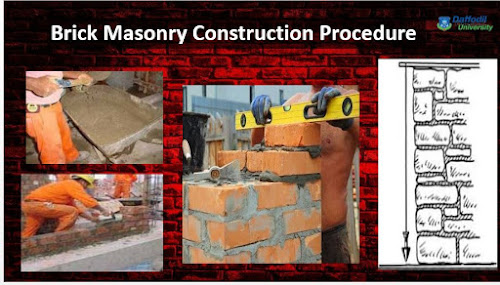Brick Masonry Definition
Brick masonry is a highly durable
form of construction. It is built by placing bricks in mortar in a systematic
manner to construct solid mass that withstand exerted loads. There are several
types of bricks and number of mortars which can
be used to construct brick masonry. The bond in brick masonry, which adheres
bricks together, is produced by filling joints between bricks with suitable
mortar. Special cautions shall be practiced while mortar is mixed and placed
since it greatly affect the performance and durability of masonry structure.
Types of Brick Masonry Work
1. Brick Work in Mud
•The mud is used to fill up various joints
brick masonry work.
•Thickness of the mortar joint is 12 mm.
•it is the cheapest type of brick masonry
•employed for construction of walls with
maximum height of 4m.
2. Brick Work in Cement
This type of brick masonry is
construction by laying bricks in cement mortar rather than mud which is used in
brick work in mud.
There are different types of brick
used in the construction of brick masonry which include:
1.Common Burnt Clay Bricks
2.Concrete Bricks
3.Sand Lime Bricks (Calcium Silicate
Bricks)
4.Fly ash Clay Bricks
5.Engineering Bricks
6.Other Brick Types include
bullnose, channel, coping, cownose
and
hollow bricks.
Materials and Equipment Used in Brick Masonry Construction
•Mortar Mix or Mason Mix Bricks
•Tape measure
• hammer
•Hose, level, or theodolite
•Trowel Level
•Wheelbarrow
•Goggles
•Jointer
• And other equipment according to
project ans
personal preferences

Brick Masonry Construction Preparations
1.Check the level of the ground
using level, theodolite or transparent hose level.
2.Set the layout of the structure.
3.Trace of building axis and wall
alignment using gypsum powder, chalk, or similar, marking the trenches for
foundation.
4.After that,install
foundation wall, cure foundation for minimum two days before beginning of brick
masonry construction.
5.Distribute bricks in several
stacks along project site to cut time and effort later.
6.Wet bricks few hours prior to the
work. Not only does this avoid absorbing too much water from mortar but
also improve adherence of bricks and mortar.
Brick Masonry Construction Procedure
1.Initially,
mix the mortar with water and blend it until a smooth and plastic mortar is produced
2.After that, place the mortar on
foundation line evenly using trowel (25mm thickness and one brick wide is
recommended for laid mortar).
3.Then, lay the first course of
stretcher bricks in the mortar. Start with second brick, apply mortar to the
head joint end of each brick, After that shove the bricks into place firmly so
that the mortar is squeezed out of all side of the joints.
4.Utilize
a level to examine the course for correct height. ensure that bricks are plumb
and level.
5.Place another mortar line
alongside the first course, then begin laying the second course.
6.Use the two half bricks to begin
the second to ensure that the first two courses are staggered for structural
purposes.
7.To finish the second course of the
lead, lay three header bricks and make sure that they are plumb and level.
8.The
third and fifth courses consists of stretchers similar to the first course. The
fourth course begins with single header, followed by stretchers. Use the level
to make sure that the lead is true on each course. Lastly, this pattern of
brick laying is used till the target height is reached
Points Considered in Supervising Brick Masonry Constructions
The
following points should be observed in the construction of brick masonry:
•Use good quality bricks.
•Ensure that brick courses are perfectly horizontal.
•Verticality of the wall should be ensured by frequently checking with
plumb-bob.
•Whenever work is stopped brick masonry should be left with toothed end.
•Use of brick bats should be avoided.
•Raising walls by more than 1.5 m in one day shall be prevented.
•Raise face joints to a depth of 12 to 20mm so as to be used as a key
for plastering or pointing.
•Brick masonry should be regularly cured for 2 weeks.
•The thickness of mortar joints shall be 10 mm both horizontally and
vertically.


















No comments